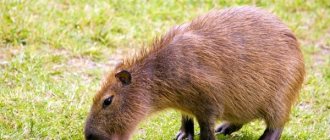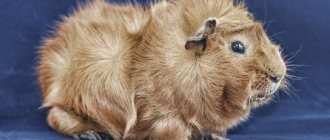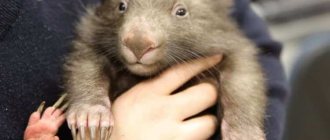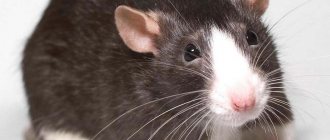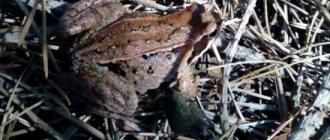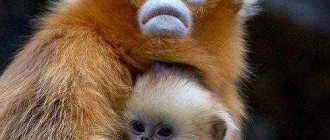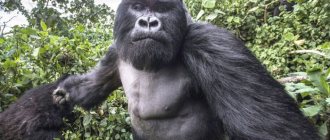general characteristics
The capybara or capybara (Hydrochaeris hydrochaeris) is a herbivore from the order of pigs. According to some reports, the ancestors of the modern capybara lived 40 million years ago in South America and were the size of a small bull. In the wild, animals prefer to settle near water, where there is enough food to raise their offspring. The closest relatives are mountain and domestic guinea pigs.
The length of mature individuals is from 1 to 1.3 meters. Body weight from 35 to 66 kg. Females are larger than males.
Life expectancy in their natural habitat is from 6 to 10 years; in captivity, with good maintenance, capybaras live from 10 to 12 years.
The capybara has a dense, short body and strong build. Externally, the animals resemble giant selfie guinea pigs. The body and head are rounded, slightly chopped off. The limbs are well developed, the forelimbs are slightly shorter than the hind limbs, so the croup is slightly raised. The forelimbs have four toes with short and slightly curved claws, adapted for digging in the ground. The hind feet have three toes with thick, strong claws. There are swimming membranes between the toes on both limbs.
While moving on the ground, capybaras walk with a leisurely, shuffling gait or waddle at a gallop. Animals swim and dive beautifully.
The head of the animals is rounded, the muzzle is rectangular, wide, elongated, blunt-nosed. The nose is black, the nostrils are wide. The ears are small and round in comparison with the general proportions. The eyes are black, small, and located on the sides of the muzzle.
Incisors grow throughout life and need regular grinding.
This should be taken into account when keeping a capybara at home. To prevent teeth from overgrowing, animals must be given twig food, bark and special stones for grinding down teeth. The incisors of males are wider and larger. The total number of teeth is 20 pieces.
Males have sebaceous, odorous glands on their faces, with which they mark their territory. The development of the glands is completed only when the individual reaches sexual maturity. Females only have anal glands; there are no glands on the nose. Females also have 6 pairs of nipples for feeding their offspring. The external genitalia are completely hidden by fur, so determining the sex of the animal is quite difficult.
The body of the capybara is covered with stiff hairs without underfur. The length in different parts of the body can vary and ranges from 29 to 123 mm. The main color is brown-red, reddish-red, beige-red and may vary depending on the climate, time of year and habitat.
Capybaras do not have sweat glands, so in hot weather they practically do not leave the water. Sometimes animals hide in dense thickets or nearby burrows of other animals.
Who is Caplin Rose?
The most famous capybara in the world is Caplin Rose (his name is an acronym meaning Rodent Of Unusual Size - Rodent Of Incredible Size), living in Texas. The animal came to the Typaldos family at an extremely tender age - when he was found, he was only about 11 days old, he slept on a pillow next to the owners’ daughter, Melanie, and woke her up with gentle grunting.
When the capybara was small, this was not much of a problem, but when he grew up, he began to lay right on his owner’s head, which began to create some problems.
Most of all (except for the owners, of course) Caplin loves to swim - and he won’t just get into the bath without first making sure that the water temperature suits him. If he finds it suitable, he will climb into the water, lie on his side and begin to clean his claws, doing a kind of manicure. The animal also loves to eat - of all the food, it especially highlights fruits and ice cream. After a swim and lunch, Kathleen goes to relax on her favorite sofa.
Koalas are the original representatives of the living world of Australia84114.811
Description of the animal
The capybara (“Master of the Grass”) is considered the only representative of the capybara family. The animal is semi-aquatic, herbivorous and is the largest representative of the rodent order. In ancient times, as paleontological finds have shown, capybaras the size of grizzly bears lived on our planet.
In order not to disappear from the face of the earth, as did its larger relatives, the capybara, in the struggle for a place in the Sun and for plant food, had to acquire some similarity with larger herbivores, both in appearance and in habits. For example, despite the fact that their legs are not as long and fast as those of the same antelopes, they also do not resemble the small legs of rodents.
And even though they move on land with a shuffling gait, if necessary, they can run quickly, suddenly jump and live in the open air, without bothering at all with digging holes.
Externally, this rodent is very similar to a guinea pig, only with a very large head. The coat is hard, from 30 to 120 mm long, red-brown or grayish in color (and only on the belly it is lighter and acquires a yellowish-brown tint). The rodent has a heavy, tightly built, barrel-shaped body, with the tibia and tibia partially fused, and the collarbone is absent. The tail is small and almost invisible.
But what is most notable is the size of the capybara, which is atypical for the order of rodents, since it is at least twice the size of the porcupine and beaver:
- The length of the rodent is a little more than one meter;
- Height at withers – about one and a half meters;
- The weight of males is about sixty-three kilograms;
- Females are slightly larger, weighing more than 65 kg.
The capybara has a large head with a short, almost square muzzle and wide zygomatic arches. The ears are small, round in shape, the nostrils are widely spaced. Since the animal's eyes, ears and nostrils are high, they make it feel extremely comfortable in the water. Males that have reached sexual maturity have a patch of skin on their face with a huge number of scent glands. The capybara has twenty teeth, while the cheek roots are absent and grow until the death of the rodent.
The front legs of this rodent are somewhat shorter than the hind legs, which gives the impression that it always wants to sit down. Capybaras have four toes on their forelimbs and three on their hind limbs. All fingers have short, strong and blunt claws, somewhat reminiscent of small hooves. Between the fingers there are membranes that allow the capybara to feel good both on land and in water.
Habitat
The capybara lives only in South America, and only in regions with a humid climate. Among the reasons that limit the spread of this animal to the rest of the territory is both the temperature of the water (in this case, these animals are quite finicky) and the air. They do not live permanently in any particular place - during the rainy season they disperse over a wide area, and gather in herds near large bodies of water when drought begins.
Regardless of the season, the capybara lives near rivers, lakes and even swamps. Sometimes they can be seen in the mountains at an altitude of about one kilometer. Since the life of this animal is extremely closely connected with water, it rarely moves more than one kilometer from the water.
Reservoirs save capybaras from pumas, jaguars and other predators. Of course, dangers also await them in rivers (for example, an alligator), but here they are not as helpless and phlegmatic as on land. The capybara swims extremely quickly, and can dive deeply and for a long time.
In water, it is able to behave very quietly and unnoticed - its nostrils and eyes are barely visible above the surface, while hiding behind algae, snags or other floating objects. It is in the water that the capybara likes to stay during the heat, with only its head out, or goes to sleep in the thickets near the pond.
This connection of the animal with water three centuries ago led to a funny situation when the Catholic Church suddenly decided to consider rodents as fish, as a result of which their meat was allowed to be consumed during Lent.
Nutrition
The capybara, living in natural conditions and not familiar with the benefits of civilization, prefers to eat plants growing in water - they contain an extremely small amount of mechanical tissue, and therefore are easier to digest by rodents. Although the capybara does not disdain grains, wild cereals, melons, sugar cane, it also eats tree bark. These animals often eat their own droppings to make the low-nutrient food easier to digest.
Capybara: appearance
The capybara is a unique animal that simultaneously resembles a domestic guinea pig and a beaver. This is the largest rodent on the entire planet, belonging to the capybara family of herbivorous mammals. Capybaras not only live in the wild, but are also very popular as pets and farm animals.
Elena
Ask a Question
Question to the expert
Does the capybara have a tail?
No. Unlike most other rodents, the capybara lacks even the rudiments of a tail.
The animals are extremely good-natured and easily get along with almost all animals and birds.
When kept in zoos, capybaras are often kept in mixed enclosures with ordinary guinea pigs, monkeys, opossums, kittens, rabbits and other non-predatory animals.
Character and behavior
Capybaras are usually very sociable and live in large groups. The average number of individuals in such groups is usually from 10 to 20, but their number can reach up to 100 animals. Each group usually consists of several adult males and females and their numerous young. Social bonds are established among members of each group, and males protect females and children. Capybaras are also territorial animals and mark their territory and objects with scent glands and urine. They are equally well adapted to moving on land and swimming in water, being very fast runners and expert swimmers.
Habitat
Representatives of the species can be found in Central and South America. The animals occupy territories from Panama to Argentina. Large concentrations of giant rodents are observed in Bolivia, Guyana, Peru, Brazil, Uruguay, Paraguay and French Guiana.
Capybaras inhabit swampy areas, lowlands, flooded meadows, river banks and lakes.
The main condition is the presence of lush vegetation and reservoirs. Sometimes animals can be found in agricultural or rice fields, as well as in water meadows.
Where does it live?
Capybaras are endemic to South America. The habitat extends to most of the continent except the highlands of the Andes and southern regions with a temperate climate.
Where does he live?
The capybara's habitat is areas near rivers, lakes or swamps. The natural areas where the rodent lives include wet and dry tropical forests and woody savannas. They can be found in foothill areas at an altitude of up to 1300 m above sea level.
Since rodents spend most of the day in the water, their traditional habitat is coastal areas. Typically, capybara families do not move more than 500-1000 m from their body of water.
Common types
There are only four known species of capybaras, two of which are considered extinct. Extinct representatives of the species Hydrochoerus ballesterensis were found in Pliocene deposits located in Argentina. The second extinct species, Hydrochoerus gaylordi, lived on the islands of Grenada and was found in Pliocene sediments around the 90s. The island species is considered endemic, since traces of its presence were found only in Grenada.
Common capybara (Hydrochoerus hydrochaeris)
The most common species found throughout the United States. These large animals can weigh from 35 to 68 kg, with a body length from 1 meter to 130 cm. Representatives of the species are peaceful animals that get along well with other forest and plain inhabitants. Capybaras are not afraid of humans and often settle near houses and farmland. Americans often feed and tame animals. Some animals get so used to people that they calmly enter houses in search of food and affection.
Small capybara (Hydrochoerus isthmius)
Unlike the ordinary capybara, the small one is less sociable and shows caution.
At the slightest threat, individuals jump into the water and dive to the depths. These representatives of the family differ little from the ordinary capybara. The only obvious difference is the size of the animals. Lesser capybaras grow no more than 80 cm in length and weigh between 30 and 45 kg. Habitat Panama, Colombia and Venezuela. Animals, like their larger relatives, have an accommodating character and good-natured disposition.
Lesser capybaras can breed throughout the year. There are from 1 to 3 babies in the litter. The cubs are born independent and can follow their mother already on the second day after birth.
The animals are social and live in small groups of 5 to 10 individuals. Typically, a family consists of one adult male and 2–3 mature females and their offspring. Males of small capybaras, unlike ordinary ones, more often live alone and join family groups only during the breeding season.
During the mating season, the alpha male vigilantly monitors the territory and females. If a stranger enters the area, the male drives him away. The dominant male fertilizes all the females of the family and does not allow young and especially stranger males to reproduce.
Small capybaras, like ordinary representatives of the species, can lead a crepuscular, nocturnal or diurnal lifestyle. Animals perfectly adapt to any weather and climatic conditions.
The number of small capybaras is stable, but the animals are constantly being destroyed for meat and fat. The capybara population is affected by the cutting down of gallery forests and drainage of swamps.
Final table of capybara species according to user ratings
Common capybara
1
Small capybara
0
Description of the rodent
— Advertising —
The body length of adult individuals is 1-1.35 m, height from 50 to 60 cm. The weight of males is 34-63 kg, females - 36-66 kg. Externally, the capybara looks like a giant, large-headed guinea pig. She has a large head with a wide, blunt muzzle, and a thick upper lip. The ears are short and round in shape. Nostrils set wide apart. The eyes are small, located high on the head and somewhat behind. The tail is practically absent. The paws are short, with four toes on the front and three toes on the hind, with short, strong claws. The capybara's toes are connected by swimming membranes. The surface of the body is covered with long and stiff hairs, from 30 to 120 mm long, there is no undercoat. From above, the capybara's body is colored from reddish-brown to grayish, the belly is usually yellowish-brown. Juveniles are lighter in color than adults. Adult males have a patch of skin on the top of their muzzle with a large number of large sebaceous glands. Females have six pairs of abdominal nipples on their tummy.
What do capybaras eat?
The capybara is a herbivorous rodent, so the basis of its diet is food of plant origin.
Capybara diet:
- grass;
- young shoots of bushes and trees;
- bark;
- leaves;
- vegetables;
- roots;
- aquatic vegetation;
- flowers;
- fruits;
- seeds of herbaceous plants, cereals;
- dry grass.
In summer, the capybara feeds on fresh greens, and in winter, the basis of its diet consists of last year’s grass, bark and roots.
Question to the expert
What to feed a capybara at home?
It is desirable that the diet be as close to natural as possible. That is, the food should be simple and coarse. It is especially important that rodents must eat twigs, shoots and other solid food every day, which ensures the grinding of constantly growing teeth. Feeding the capybara “from the table” is strictly prohibited.
Captivity
Capybara is the friendliest animal. Capybaras do not show aggression and coexist peacefully with both their relatives and their neighbors: birds, turtles, beavers and other mammals, including large ones.
When kept at home, this large rodent quickly finds contact with humans and easily gets along with other pets. Capybaras have a fairly developed intelligence, so they are easily tamed and even trainable.
Before you decide to keep a capybara as a pet, you need to think about how to provide it with the opportunity to bathe. This pet is best suited for owners of private houses with a pool or pond on the property.
TURTLE
Lifestyle and character traits
Capybaras lead a sedentary lifestyle and rarely travel. Migration may be caused by dry periods, lack of food, displacement of animals by humans, or fires. Typically the family lives in an area of 1 to 2 km along the coastline or swamp.
Animals rarely move more than a kilometer away from water.
Lifestyle of the capybara
Capybaras spend most of their time in or near water. It is there that they find the most juicy and tasty vegetation. In addition to providing abundant nutrition, water protects animals from overheating and predators.
Recommended by topic
Fox Panda Lynx
These are diurnal animals, but if they are bothered by predators, people or heat during daylight hours, they easily switch to nocturnal mode. Adaptation to any time of day helps capybaras survive and maintain numbers, regardless of almost any changes.
On the ground, animals move at a walk and very rarely run. Large and clumsy animals can reach speeds of up to 35 km/h, but at this pace they can only run short distances. In water, capybaras feel protected and swim and dive well. When swimming and moving through the water, animals keep their heads above the surface. Water does not get into the high-set eyes, nostrils and ears, and the membranes on the paws allow them to develop decent speed.
Capybaras do not dig holes or build nests. Typically, adult animals roost in dense coastal vegetation and, if necessary, easily move to another place.
Before giving birth, females choose a secluded corner and can leave it with the brood the very next day. Capybara cubs are born independent, so they can follow their mother immediately after birth.
Character and habits
Capybaras are social animals and rarely live alone. Usually these are young males who are expelled from the family by alpha individuals. Later, young exiles either return to their family or join another group. But most often, young individuals are taken away from the families of young females and create a new group.
Capybaras form groups of 10–30 individuals. The family is dominated by the largest and strongest male and several females. Other members of the family are young, subordinate males and females, as well as cubs.
Recommended by topic
Weasel Tit Arctic fox
Surprisingly, during periods of drought, families do not disintegrate, but, on the contrary, unite with other groups. During drought, herds of 100 to 150 individuals can accumulate in one place near water bodies.
Males mark their territory with the help of anal glands and the secretion of the olfactory gland. Scent marks warn intruders that the territory is occupied and attract females during the breeding season. Males rub their glands against stones, grass, bushes and other vegetation, leaving their scent throughout the area that the family occupies.
In case of danger, the group runs deeper into the water, and the kids hide in the coastal thickets. Despite the clumsiness of their prey, predators very rarely manage to feast on capybaras.
During the summer of insects, capybaras roll in the mud, which forms a dense crust on land. Such protection cannot be bitten by annoying, blood-sucking insects, and it also perfectly protects animals from overheating.
Elena
Ask a Question
Question to the expert
What sounds do capybaras make?
Animals communicate using whistles, barks and clicks. The range of capybaras closely resembles the sounds made by common domestic guinea pigs.
Surprisingly, bird chirping and whistling can sound like morning or infrasound. The sensitive ears of animals perfectly perceive any range. Researchers have long noticed that by changing their tone, capybaras can “directly” address any member of the group.
Dissatisfied or frightened rodents may yap at their relatives or warn them of danger.
While feeding, females may purr or coo. They close their nostrils tightly and make iridescent sounds.
Lifestyle and habitat
Capybaras are herd animals. They form groups that include 3-5 males, 4-7 females and young animals. Relationships in the group are complex. The males rule, among whom there is a clear leader. Due to the presence of a single leader, males have little conflict. A male who aspires to the main role, but fails to win or defend it, often leads a bachelor life and lives separately from the herd.
Sounds serve as a means of communication and control. But there are few of them in the arsenal of rodents. The main signal is something like a dog barking. It serves to scare away enemies and pacify wayward fellow tribesmen. Smells are more important. The main content of odorous messages from males is a claim for territory ownership. The female uses scents to communicate her readiness to continue the race.
To generate odorous substances, glands located on the muzzle and under the tail are used. The subcaudal (anal) glands are surrounded by hairs that fall out easily when touched. Males leave these hairs on the grass and bushes; they emit a scent for a long time, the meaning of which is clear to other capybaras.
The capybara lives in all countries of South America except Chile. Groups of capybaras and solitary animals graze in tall deciduous forests near water bodies. Capybaras like swamps, low-lying lakes and rivers. During the rainy season, capybaras thrive in flooded areas of savannas. The capybara in the photo most often poses standing in the water.
Typically, a capybara family develops an area of 10 hectares or more. In the rainy season, with a large harvest of grass, the area of the plot may decrease. When drought occurs, rivers become shallow, which forces them to migrate to non-dry bodies of water. Competition for water and food is intensifying. But capybaras do not fight, but create large herds (100-200 heads), which are controlled by a group of males.
Families of capybaras, in search of food, water and safety, often wander into ranches and pens and successfully coexist alongside large herbivores. Capybaras found suitable living conditions in Florida and California. Where former domesticated but escaped animals began to form North American populations.
Herds and solitary capybaras live in areas where predators are abundant. In the forest, capybaras can end up as lunch for a leopard; in their native water element, a capybara can be attacked by a crocodile or anaconda; from the sky, piglets and adult animals can be attacked by eagles and hawks. Under significant pressure from predators, capybaras can change their mode of life: rest in a shelter during the day, feed at night.
Reproduction and raising of offspring
Capybaras become sexually mature at approximately 1.5-2 years, with a body weight of about 40 kg.
Not only alpha individuals participate in reproduction. Along with the leaders, other females are also allowed to mate. While young males are often left without a mate or expelled by the leader for the entire estrus period.
Mating season
Animals, given good conditions and sufficient food, can reproduce throughout the year. But the main mating season begins with the arrival of the rainy season. The duration of mating games is from April to May. After the birth of the offspring, the female goes into estrus after a short period of time and is again ready to mate. On average, female capybaras can produce 1–2 litters per year.
A distinctive feature of capybaras from other rodents is that mating most often occurs in water. This may be due to the greater weight of males and females.
Duration of pregnancy and childbirth
Gestation of offspring takes on average from 120 to 150 days. The duration of pregnancy depends on the number of fetuses, climate zone, size and age of the female. As well as weather conditions and nutrition. Childbirth occurs between September and October.
Females do not build nests, but simply look for a secluded place. Usually the female leaves the group 1 day before the babies are born and hides. Often one or two young females go with her. Surprisingly, females can help each other during childbirth. Together they lick their offspring and warm newborn babies.
Childbirth occurs on the ground or on a grass bed. After just two or three days, the capybara leaves the maternity area and goes in search of food along with the babies.
On average, a female brings from 1 to 8 cubs.
The weight of the cubs is from 1 to 1.5 kg. Newborn babies are covered with fur, with developed teeth and open eyes. Already on the second day, small capybaras can follow their mother and begin to try plant food.
Caring for the Cubs
The female feeds the babies with milk for 3 to 4 months, but the cubs begin to try food already in the first week after birth. Usually the female will stop feeding if she is expecting the next litter.
At this time, mothers actively feed in order to maintain body weight, since feeding and raising offspring takes a lot of effort.
Males and females of the family help care for the babies indiscriminately between their own and others. Adults lick and clean the cubs, and also protect them in case of danger. A reverent attitude towards the offspring and care help the group raise children with virtually no losses.
In case of danger or attack by predators, adult animals make sharp whistling sounds.
The kids rush to the thicket as if on command and sit very quietly. After the threat has passed, the small capybaras leave the shelter. If danger catches animals in an open area, then the adults huddle together around the cubs and try to scare away the predator. At the same time, the entire group slowly backs away towards the water.
When the cubs grow up, they rarely leave the group.
Typically, mature male capybaras leave their mother and family at the age of two, when they become sexually mature. Females often do not leave their usual habitat at all and live with their family all their lives.
Hippopotamus or fish?
Like the hippopotamus, it is a semi-aquatic mammal: it feeds and hides from danger in the water; even mating takes place there. In order for the capybara to see and breathe while swimming, when most of its body is hidden under water, the eyes, ears and nostrils are located high on the head, like a hippopotamus. When the animal floats to the surface of the water, it is almost invisible. Hiding from predators, capybaras can stay underwater for up to 5 minutes. They can even sleep underwater with their nostrils pointed above the surface. In the 16th century, the Catholic Church classified the capybara as a fish so that its meat could be eaten on Fridays and during Lent.
Natural enemies
In the wild, capybaras have few enemies. Typically, predators attack animals that are young, old, or weakened by disease.
Natural enemies:
- wild and feral dogs;
- urubu vultures;
- anacondas;
- jaguars;
- ocelots;
- large crocodiles.
After the resettlement, the first European colonists actively caught and destroyed capybaras, because they thought that they were poisoning agricultural fields. But over time, it became clear that rodents mainly eat only aquatic vegetation and the targeted destruction of animals stopped.
The greatest harm to capybaras is caused by droughts, fires and anthropogenic factors. Artificially drained swamps and changes in the direction of rivers and streams lead to the migration of rodents and sometimes to death.
What does a capybara eat and how does it live?
The Indians call the capybara the “master of herbs”, since this rodent is a herbivore. With its sharp teeth, the capybara cuts the grass like a razor. The capybara eats fruits and tubers of plants. In addition, the capybara eats hay and various aquatic plants.
The capybara lives, being active during the daytime and leads a semi-aquatic lifestyle. In some cases, the capybara can switch to a nocturnal lifestyle. The capybara lives near the water, so it does not move more than 1 km from the shores of the reservoir.
The entire life of a capybara is associated with fluctuations in water levels. During the rainy seasons, capybaras disperse throughout the area, and during the dry season they gather along the banks of rivers and reservoirs. The capybara animal can travel quite long distances in search of water and food. The capybara rodent swims and dives well, while feeling more confident in the water than on land. Highly located eyes, ears and nostrils allow the capybara to keep them above the water while swimming.
The capybara rodent is a social animal and has its own hierarchy. Capybaras live in groups that consist of 10-20 individuals. The leader in such groups is the dominant male. There are also several females in the group (they have their own internal hierarchy), cubs and subordinate males. Occasionally, capybaras live alone, and even then only males. It often happens that a dominant male expels other males from the group in order to avoid competition.
Groups of capybaras become larger in arid areas. During periods of drought, several hundred capybaras can gather along the banks of reservoirs. On average, a herd of capybaras has a territory of up to 10 hectares. But they spend most of their time on a plot of only 1 hectare. The boundaries of the capybara's area are marked with glands. The capybara animal does not welcome strangers on its territory. Communication between capybaras is carried out using various clicking and barking sounds, whistling, and smell. During the mating season, males mark vegetation with their secretions to attract females.
Capybaras do not build dwellings; they simply live on the territory of their possessions, where they sleep and relax directly on the ground or swimming in the water. Only sometimes can a capybara dig a small hole in damp ground to make it more comfortable. It is not uncommon to see various small birds perched on capybaras. There is a mutually beneficial relationship between rodents and these birds. The birds clean the capybaras' fur of insects, obtaining food and helping the capybaras get rid of parasites. Using the same principle, birds clean insects and giraffes.
The capybara has enemies in the wild. On land, the natural enemies of the capybara animal are wild dogs, jaguars and ocelots. The capybara hides underwater from these predators, breathing through nostrils that remain on the surface. But even in the water, the capybara has plenty of enemies: anacondas, alligators, crocodile caimans and Orinoco crocodiles.
The capybara animal is not a protected species. Agricultural activities of people most often benefit these rodents, thereby providing them with water and food during periods of drought. Therefore, the number of capybaras in human-developed areas can be significantly higher than in the wild. Currently, on special farms in Venezuela, capybaras are bred for meat and leather products. In appearance and taste, capybara meat resembles pork. Capybara fat is used in pharmaceuticals, as is badger fat.
The capybara transmits Rocky Mountain spotted fever (states of Sao Paulo, Rio de Janeiro and Minas Gerais, Brazil). This disease is transmitted to people through the ixodid tick, which parasitizes capybaras that enter farms and pastures.
Recently, people are increasingly keeping various exotic animals at home. The capybara was no exception; today this rodent is becoming a pet. This is not surprising, because the capybara is an extremely calm and trusting animal that gets along well with other domestic animals and is easily tamed.
In addition, the capybara animal lends itself well to training, is distinguished by its cleanliness and unpretentiousness in maintenance. The most important thing is to make sure that the animal is absolutely healthy.
Interesting Facts
Capybaras are unlike anyone else, they are interesting animals. Unusual rodents still attract the interest of scientists and nature lovers. Although capybaras do not lead a secretive lifestyle, there are still blank spots in their behavior and daily routine that have yet to be filled.
Interesting:
- Capybaras are the largest rodent on the planet.
- The capybara's closest relative is the guinea pig.
- Animals do not even have the rudiment of a tail.
- Babies are born completely independent.
- To scare away insects, capybaras roll out in the mud, which dries in the sun.
- The eyes, ears and nostrils are equipped with special flaps that prevent water from entering the holes during dives.
- Capybaras can get sunburned in the bright sun and get skin burns.
- Animals do not have undercoat, so they are considered hypoallergenic.
- Huge rodents cannot live away from bodies of water.
- Translated, the scientific name Hydrochoerus hydrochaeris sounds like water pig.
- Several centuries ago, capybaras were equated with fish. The Catholic Church considered animals to be aquatic, so they were allowed to be eaten during Lent.
- The record weight of an adult is 73.5 kg.
- There are membranes between the toes of the front and hind limbs.
- In Venezuela, capybaras are bred as farm animals. Rodent meat is considered a delicacy, and the fat is used in the pharmaceutical industry.
- Capybaras are very friendly and never attack other animals.
- In hot weather, giant rodents do not leave the pond because they lack sweat glands. Water is the only natural source of cooling.
- Usually, families do not divide children into their own and those of others. Therefore, female capybaras can feed not only their cubs.
- Giant rodents rarely live alone and form groups of 10 to 40 individuals.
- Capybaras can dive and hold their breath for about five minutes.
- The body of animals is covered with hairs that repel water.
- Animals do not have collarbones.
- To be satisfied, an adult capybara needs to eat 3 to 4 kg of grass per day.
- Capybaras are autocoprophages, so to better digest food, rodents eat their morning feces.
- Rodents are excellent learners, so in some countries they began to be used as guide dogs.
- The brain of a capybara is the size of an average lemon.
In addition to all of the above, it is believed that the capybara is the friendliest creature on the planet.
They easily find contact with humans and other living beings. Recently, the capybara has become a popular pet. But before you get an exotic rodent, you need to weigh the pros and cons. First of all, you need to understand that this is not a small hamster or a guinea pig. Adult capybaras can grow from 1 to 1.3 meters and weigh about 40–60 kg. Such a pet requires a lot of free space for living and playing. The capybara cannot be kept in a cramped cage; it needs a spacious yard and an enclosure. In addition, the capybara is a social animal and will be sad without its own kind.
It is also worth considering that the diet of waterfowl rodents has its own differences. There is no store-bought food for capybaras, so you will have to create a diet from scratch. Daily portions should contain succulent aquatic vegetation and other specific ingredients.
The advantages include the absence of odor, rare molting and the innate friendliness of unusual rodents.
Interesting facts about the rodent:
- The name of the capybara from the dead Tupi language (which is related to the language of the Guarani Indians) is translated as “fine grass eater”. In its closest form to the original, capivara, the word entered the Portuguese language and is widely used in Brazil. In the form “capibara” the name has taken root in English, Russian, Japanese and a number of other languages. In Latin American countries where Spanish is spoken, other names for this type of animal are used, for example, “carpincho” (in Argentina and Peru), “chigüiro” (in Venezuela and Colombia), “jochi” (in Bolivia), “ñeque "(in Colombia).
- The scientific name of the species “Hydrochoerus hydrochaeris” means “water pig”, which is where the word capybara came from in Russian.
- Several centuries ago, the Catholic Church classified capybaras as fish, due to which their meat was considered lean and was allowed to be consumed during Lent.
- The capybara is not a protected species. Human agricultural cultivation and the creation of fields and pastures benefit capybaras by providing them with food and water during periods of drought. The number of capybaras in grassland areas is usually greater than in undeveloped land. The highest population density is 2-3.5 individuals per hectare.
- In Venezuela, capybaras are bred semi-wildly on farms to produce meat and leather goods; they are also used as a source of fat for the pharmaceutical industry. Capybara meat is similar in taste and appearance to pork.
- Capybaras are the natural reservoir of Rocky Mountain spotted fever (states of Sao Paulo, Rio de Janeiro, Minas Gerais, Brazil), which is caused by the pathogen Rickettsia rickettsii. This disease is transmitted to humans through the ixodid tick (Amblyomma cajennense), which parasitizes capybaras.
Capybara invasion in Argentina
The invasion of capybaras in Argentina was reported in The Guardian. They appeared on the territory of the elite settlement of Nordelta, where more than 25,000 people live. This village was built in 1999 on a wetland specifically for people who wanted to live closer to nature. Construction was carried out despite the protests of environmentalists, who were categorically against the destruction of wild animal habitats. It was simply outrageous - people wanted to live in nature, but on the condition that there would be no rodents, snakes and other animals there.
Argentine Nordelta
Wealthy developers, backed by the government, are destroying wild environments to fulfill people's dream of living in nature. But the people who buy these houses want nature without mosquitoes, snakes and capybaras, environmentalists explained.
Local residents noticed the capybara invasion around August 2021. Since these creatures usually live in groups of 10-20 individuals, it was simply impossible not to notice them. In addition, they not only appeared, but began to spoil lawns and even bite domestic animals like dogs. Some people even went out to shoot them, which is strictly prohibited. Conservationists believe that since this area was the natural habitat of the capybaras, they simply decided to return to their home. And there is nothing to blame them for.
Behavior in nature
The capybara is a semi-aquatic animal, so it prefers to live near water. Here the capybara cools off, takes water treatments, and hides from enemies.
Note!
Animals of the Red Book of Russia: complete list of animals, photo, name, description
- A Guide to Fish Oil and Omega-3
- Koala: photo, lifestyle, habitat, habits, character, types, interesting facts
They love water very much and rarely stray far from it. They swim well and dive deeply. They spend quite a lot of time in the water. Looking for food, they are able to cover kilometers of distance.
The capybara does not build a home. They live in a designated area and can sleep on bare ground or in a river. They are active during the day. If there are people nearby, they switch to a nocturnal lifestyle.

